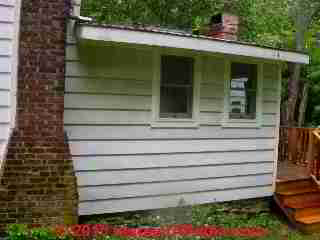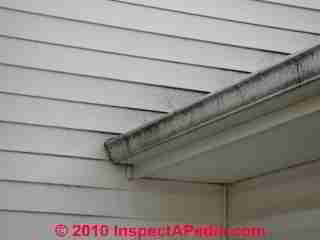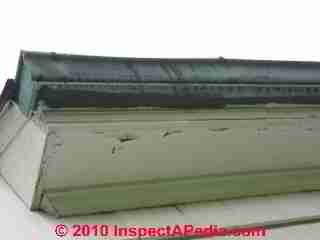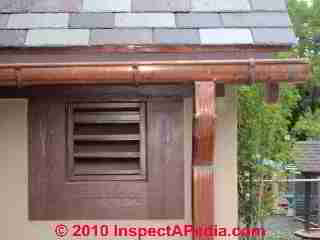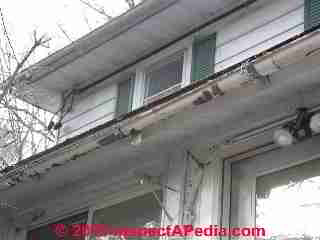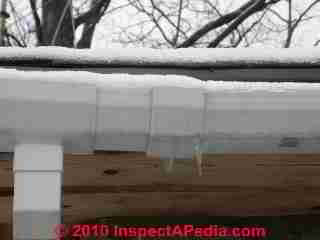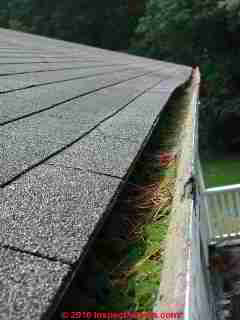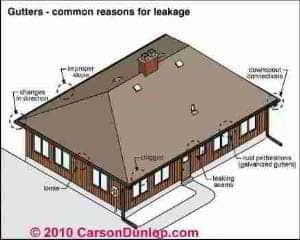 Roof Gutters & Downspouts
Home Page
Roof Gutters & Downspouts
Home Page
- POST a QUESTION or COMMENT about roof gutters, downspouts & other roof drainage control systems
Building gutters, leaders, roof drainage systems:
In this article series we describe good gutter and downspout installation details, the need for roof gutters and drainage systems, and we describe the types of roof gutters used on buildings. This article series discusses how to choose, install, diagnose & maintain roof gutters & downspouts, & roof drainage systems to prevent building leaks and water entry.
InspectAPedia tolerates no conflicts of interest. We have no relationship with advertisers, products, or services discussed at this website.
Guide to Roof Gutter & Downspout Systems
Our page top sketch of common roof gutter leak causes is provided courtesy of Carson Dunlop Associates, a Toronto home inspection, education & report writing tool company [ carsondunlop.com ].
Quoting from Carson Dunlop Associates' Home Reference Book:
Gutters and downspouts have two major functions. Firstly, they protect the walls of a building from water that would ordinarily run off the roof.
This water can damage the wall surfaces and cause localized erosion at ground level.
The most important function of gutters and downspouts in homes with basements or crawlspaces, however, is helping to ensure a dry basement.
Regardless of the foundation type, there is always the risk of water penetration.
The less water there is in the soil near the foundation wall, the lower the risk of water penetration into the basement.
Gutters should collect all water run off, and downspouts should discharge the water into proper drains or onto the ground well away from the foundation walls
[Click any image or drawing to see an enlarged, detailed version.]
Are Gutters Really Necessary?
If your building is located where it rains
or where there is snow-melt, your building probably needs a roof drainage system to carry water away from the building in order to prevent leaks into the building, especially if the building includes below-ground areas such as a basement or crawl area.
A very large percentage of basement or crawl space water entry, moisture, leaks, rot, and mold problems all begin at the building roof, with the failure to adequately capture roof runoff and to direct it away from the building.
We have met a few architects who never include gutters in their building design, arguing that "Gutters are ugly, and besides we've never had a water entry problem in our homes."
Yet every home we inspected of that design had a wet basement within a short time of construction, sometimes even during construction, [excepting in arid climates of little rainfall, homes built on slabs with no basement or crawl area, or homes whose surrounding soils incorporate special subsurface drainage systems].
Even where a roof drainage system such as simple gutters and downspouts are installed, errors in their installation or failure to maintain (and clean out) clogged gutters remains a most common source of wet basements and crawl spaces.
Fix the Gutters Before Installing a Basement de-Watering System
Watch out: While on occasion we find a home that was built over a spring or stream bed, or was unfortunately located at the bottom of a hillside, even then, mis-handling of water coming off of the building roof is very often a major source of chronic basement leakage.
Before installing a costly basement de-watering system to cure "rising damp" or "high water table flooding" at your building, making an expert inspection of the condition of the gutter and downspout system is worthwhile.
In some climates some roofs and buildings make it difficult to install and keep gutters on the roof. For example a standing seam metal roofed building in a climate subject to heavy snowfall or ice formation may keep losing its gutters to sliding snow and ice. Proper gutter installation details and snow guards can solve this problem on some buildings.
See SNOW & ICE DAMAGE TO BUILDING GUTTERS for details.
Where those steps don't work, a more costly and extensive surface and subsurface installation of geotextiles and waterproof drainage mats below the soil surface (or below gravel) at the building eaves can be constructed to keep water away from the building foundation, draining it to a distant catch basin or lower site area.
Types of Gutter & Roof Drainage Systems
Gutter Types by Profile or Shape
By examining the shape or "profile" of a gutter from the ground we can often determine whether it is made of aluminum (below), galvanized steel, or plastic. It's also usually easy to identify copper gutters even from ground-level inspection, as we illustrate below.
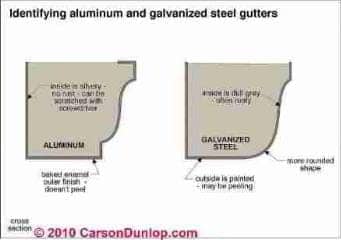
The sketch at left shows a traditional "K" profile aluminum gutter at left, and a more-rounded galvanized steel gutter at right.
Sketch courtesy of Carson Dunlop Associates, a Toronto home inspection, education & report writing tool company [ carsondunlop.com ].
Gutter Size & Capacity:
the gutter size needed at a building depends on the total roof area being drained and the length of gutter available to collect that water. The most common gutter sizes are 4-inch and 5-inch widths.
Details are at GUTTER SIZES
Types of Gutter Hangers or Supports:
are discussed separately
Aluminum K-Gutter Shape & Profile photos
The aluminum gutter shown below is commonly referred to as a "K" gutter because of its gutter profile, as shown in the gutter profile sketch above. Aluminum gutters are widely used in North America as they are light, easy to install, and corrosion resistant.
The outer gutter surface is a baked enamel finish available in white, brown, green, and black. The interior surface may be a silver or bronze color depending on plating.
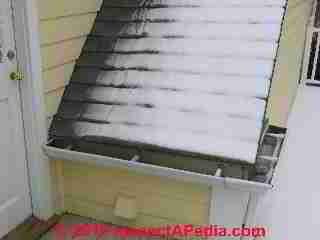
Aluminum gutters are easily bent such as by an inspector's ladder or by careless chopping of ice at the roof edge. Connections among gutter sections are made using a combination of slip-joint connectors and sealant, often butyl caulk.
Copper Gutter Shape & Profile photos
Copper gutters are readily identifiable by their characteristic colors (red, brown, or marked with a green patina).
Copper gutters are provided in a variety of profiles including the "K" shape (shown below), a rectangular or "box" shape that may be custom fabricated for the building, and traditional half-round design.
The copper gutter shown at below right was custom fabricated to fit at the wall top of the building.
You will notice the brown oxidized copper interior of the gutter and the green copper patina on the gutter's exterior and upper edge.

New half-round copper gutters and rectangular copper downspout are shown below.
Next below, we show an underside-view of traditional half-round copper gutters and a recently-installed round copper downspout.
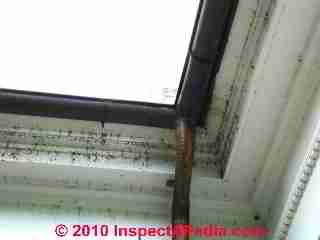 <
<
Galvanized Roof Gutters Shape & Profile photos
Galvanized roof gutters are provided in both "K" and half-round profiles, though the half-round profile is perhaps most common.
Our galvanized half-round gutter photo at below left shows that the gutter is rusted and overflowing.
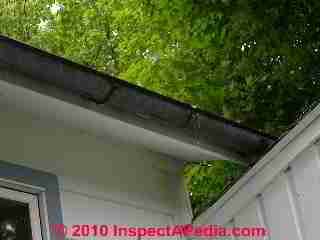
Below, the half-round galvanized gutters were painted but have rusted through, sagged, and are at end of their useful life.
Plastic Roof Gutters Shape & Profile photos
Plastic roof gutters are popular with "do-it-yourself" homeowners, perhaps because the connecting gutter and downspout parts appear to snap together nicely and may include built-in gaskets in the gutter connectors.
We often find that plastic roof gutter systems are under-sized, inadequately supported, and loose.
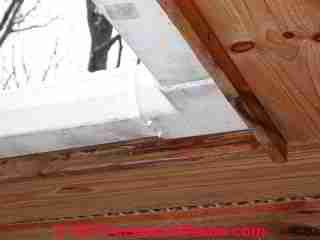
Hung Wood Gutters Shape & Profile photos
Our hung wood gutter photo (below left) shows a common type of gutter used in North America: the gutter was actually carved out of a solid piece of wood. You can also see that while wood gutters may have lasted a very long time, sometimes up to 50 years, eventually the gutter is both rotted and filled with moss.
Wood gutters are more attractive than some metal alternatives but require considerable maintenance if they are un-lined: annual inspection, caulking at seams, and treatment with a preservative oil. The heavy moss found in this hung-wood gutter makes clear that it had not been inspected nor cleaned for a long time.

Our second wood gutter photo (above right) was observed on a sod roof in Molde, Norway.
This wood gutter approach is similar to a Yankee gutter but without brackets and using a larger timber to form the gutter side. The larger timber is used to help keep sod from sliding down or washing off of the roof surface.
...
Continue reading at GUTTER DEFECTS LIST or select a topic from the closely-related articles below, or see the complete ARTICLE INDEX.
Or see these
Recommended Articles
- GUTTERS & DOWNSPOUTS - home
- DOWNSPOUT / LEADER DEFECTS
- DOWNSPOUT LEAKS
- DOWNSPOUT DEFECTS, OTHER
- DRYWELLS, FRENCH DRAINS for FLAT SITES
- FLAT ROOF DRAINAGE SYSTEMS
- FLOOD DAMAGE ASSESSMENT, SAFETY & CLEANUP
- GRADING, DRAINAGE & SITE WORK
- GUTTER CAPS
- GUTTER DEFECTS LIST
- GUTTER HANGERS
- GUTTER REPAIR, LEAKY JOINT
- GUTTER SCREENS
- GUTTER SIZES
- GUTTER TYPES
- HEAT TAPES & CABLES for ROOF ICE DAMS
- MOISTURE CONTROL in BUILDINGS - home
- SNOW & ICE DAMAGE to GUTTERS
- SURFACE CONTOURING for DRAINAGE
- WATER ENTRY in BUILDINGS
Suggested citation for this web page
GUTTERS & DOWNSPOUTS at InspectApedia.com - online encyclopedia of building & environmental inspection, testing, diagnosis, repair, & problem prevention advice.
Or see this
INDEX to RELATED ARTICLES: ARTICLE INDEX to GUTTERS & DOWNSPOUTS
Or use the SEARCH BOX found below to Ask a Question or Search InspectApedia
Ask a Question or Search InspectApedia
Questions & answers or comments about roof gutters, downspouts & other roof drainage control systems
Try the search box just below, or if you prefer, post a question or comment in the Comments box below and we will respond promptly.
Search the InspectApedia website
Note: appearance of your Comment below may be delayed: if your comment contains an image, photograph, web link, or text that looks to the software as if it might be a web link, your posting will appear after it has been approved by a moderator. Apologies for the delay.
Only one image can be added per comment but you can post as many comments, and therefore images, as you like.
You will not receive a notification when a response to your question has been posted.
Please bookmark this page to make it easy for you to check back for our response.
Our Comment Box is provided by Countable Web Productions countable.ca
Citations & References
In addition to any citations in the article above, a full list is available on request.
- Dampness in buildings, Diagnosis, Treatment, Instruments, T.A. Oxley & E.G. Gobert, ISBN 0-408-01463-6, Butterworths, 1983-1987 [General building science-DF]
- Mark Cramer Inspection Services Mark Cramer, Tampa Florida, Mr. Cramer is a past president of ASHI, the American Society of Home Inspectors and is a Florida home inspector and home inspection educator. Mr. Cramer serves on the ASHI Home Inspection Standards. Contact Mark Cramer at: 727-595-4211 mark@BestTampaInspector.com
- John Cranor [Website: /www.house-whisperer.com ] is an ASHI member and a home inspector (The House Whisperer) is located in Glen Allen, VA 23060. He is also a contributor to InspectApedia.com in several technical areas such as plumbing and appliances (dryer vents). Contact Mr. Cranor at 804-873-8534 or by Email: johncranor@verizon.net
- Our recommended books about building & mechanical systems design, inspection, problem diagnosis, and repair, and about indoor environment and IAQ testing, diagnosis, and cleanup are at the InspectAPedia Bookstore. Also see our Book Reviews - InspectAPedia.
- Building Pathology, Deterioration, Diagnostics, and Intervention, Samuel Y. Harris, P.E., AIA, Esq., ISBN 0-471-33172-4, John Wiley & Sons, 2001 [General building science-DF - ** Particularly useful text **
- In addition to citations & references found in this article, see the research citations given at the end of the related articles found at our suggested
CONTINUE READING or RECOMMENDED ARTICLES.
- Carson, Dunlop & Associates Ltd., 120 Carlton Street Suite 407, Toronto ON M5A 4K2. Tel: (416) 964-9415 1-800-268-7070 Email: info@carsondunlop.com. Alan Carson is a past president of ASHI, the American Society of Home Inspectors.
Thanks to Alan Carson and Bob Dunlop, for permission for InspectAPedia to use text excerpts from The HOME REFERENCE BOOK - the Encyclopedia of Homes and to use illustrations from The ILLUSTRATED HOME .
Carson Dunlop Associates provides extensive home inspection education and report writing material. In gratitude we provide links to tsome Carson Dunlop Associates products and services.


